| MAN Category 1 | |
|---|---|
 MAN Category 1 5,000 kg 4×4 cargo truck of the German Bundeswehr. When fitted with a winch, the Bundeswehr designation for this vehicle is Type 461 LKW 5t mil gl MW Pritsche, without a winch, the designation is Type 451 LKW 5t mil gl Pritsche | |
| Type | 8x8, 6x6, and 4x4 off-road trucks |
| Place of origin | West Germany |
| Service history | |
| Used by | West Germany, Belgium, France, Canada, Austria, USA, Estonia and probably others |
| Production history | |
| Manufacturer | MAN SE; RMMV would now be the design parent |
| Produced | 1976-1981 (Category 1) |
| No. built | 9110 (approx) |
| Specifications | |
| Crew | 1 + 1 |
| Engine | MAN water-cooled diesel (KHD air-cooled diesel in early models) varied by model |
| Payload capacity | 5,000 kg (4x4), 7,000 kg (6x6), 10,000 kg (8x8); Category 1 A1 increased 8x8 payload to 15,000 kg |
| Transmission | usually ZF manual with torque convertor and two-speed transfer case |
| Suspension | coil springs and dampers for each axle |
Steering system | power-assisted on front axle(s) |
The MAN Category 1 is a family of high-mobility off-road trucks developed by MAN SE for the German army. Production continued through an evolution of the design with the final iteration (SX) in production until early 2019.[1]
History
In the late 1950s and early 1960s the West German Technical Office for Armament and Military Purchases drew up requirements for a new range (or second generation) of vehicles for the army. Covering all weight classes and mobility levels, the Bundeswehrʼs second-generation requirement originally called for 62,000 vehicles (of all classes including cars and buses) including four-tonne 4×4, seven-tonne 6×6, and 10-tonne 8×8 trucks; 4×4 and 6×6 armoured amphibious load carriers; and an 8×8 amphibious reconnaissance vehicle.[2]
To meet development and production demands, a joint venture led by MAN and including Klockner-Humboldt-Deutz (KHD), Rheinstahl-Henschel, Krupp (which later dropped out), and Büssing (acquired by MAN in 1971) was set up. The first prototype vehicles were shown at the end of the 1960s, and a further two prototype series were developed before the first genuine pre-production vehicles were designed and built. Along the development trail it became clear that the highly technical vehicles as originally specified would simply not be affordable, so many of the more ambitious 'wish list' features were dropped; truck numbers were also reduced to 18,000. In 1972 the amphibious specification and the requirement that the vehicles should be powered by an air-cooled multifuel engine were dropped. In 1975 the four-tonne rating was uprated to five-tonne and at the same time this model’s rear cargo platform was lengthened and the wheelbase was increased from 4.3 to 4.5 m.[2]
In December 1975 MAN was awarded a contract to build 8,385 4×4, 6×6, and 8×8 Category 1 vehicles at a cost of DEM1,400 million; this production total was further reduced to 7,925 in 1979. The technical parent of these trucks is now Rheinmetall MAN Military Vehicles (RMMV).[2]
The 8×8 version was the first Category 1 model to enter production and first deliveries were made in 1976. Deliveries of a 6×6 tipper and the 4×4 cargo truck began in 1977. Deliveries of the 6×6 cargo truck began in January 1979; final deliveries were made in 1981. By 1983, 8,617 vehicles of all Category 1 configurations had been delivered to the West German armed forces, and while exact delivery totals are unknown, the Bundeswehr did receive a total of 7 Category 1 5,000 kg 4×4 variants, 14 Category 1 7,000 kg 6×6 variants, and 9 Category 1 8×8 10,000 kg variants. The complete range of Category 1 vehicles were produced at MAN’s Watenstedt plant in Germany.[2]
Category I vehicles underwent a complete overhaul in the mid-1990s to extend their service life by another ten years, and replacement has only recently begun in earnest. Some ex-military MAN Category 1 vehicles have been released onto the second-hand market in Germany.[3]
Description
Introduced as the mil gl (for "militarisiert geländegängig" - military, cross country mobile), the MAN Category 1 series was used by all branches of the Bundeswehr. Militarisation includes a full blackout lights circuit completely separated from the standard lights, a military instrument layout with blackout option, an emergency stop switch to cut electrical power, a roof hatch with machine gun mount, and rifle brackets.[2]
All Category 1 (and follow-on series) share a modular design. They have a torsionally rigid box-section chassis frame with rigid hub-reduction axles sprung by coil springs and shock-absorbers. The engine is mounted inside the forward-control cab, which is separated into a driver and engine compartment by a firewall. The engine is located to the rear of the driver compartment instead of beneath it, this enabling total height to be kept below 2.9 m, which means the trucks can be transported on standard railway flatcars. The characteristic, cut-away corners of the otherwise box-shaped cab ensure compliance with the railway loading gauge. The cab of early production examples does not tilt forward for maintenance because the vehicles were still based on the amphibious prototypes. The tilting cab was only introduced in the mid-80s.[2]
The KHD air-cooled diesel engine powers all axles via a torque converter, semi-automatic transmission and a transfer case, these components forming a single unit. The follow-on A1 series employed a far greater use of mass-produced and standard truck components. For the extraterritorial deployment of the Bundeswehr, some vehicles were fitted with an additional modular armour (modulare Schutzausstattung, MSA) to increase crew protection.[2][1]
Category 2 (US military)
The United States Army and the United States Air Force operated four derivations of the KAT 1 8x8, these known as Category 2 trucks and designated M1001, M1002, M1013 and M1014 by the US military.[4] Category 2 trucks were developed at the request of, and in close co-operation with, the US armed forces.
- Truck Tractor w/Crane, 10-ton, 8X8 M1001 (NSN 2320-12-191-5422)
- Truck Tractor w/Crane, 10-ton, 8X8, M1002 (NSN 2320-12-191-5423)
- Truck Tractor w/Crane, 10-ton, 8X8, M1013 (NSN 2320-12-191-5424)
- Truck Tractor w/o Crane, 10-ton, 8X8, M1014 (NSN 2320-12-191-5425)
The M1001 was used by the US Army as the prime mover for the Pershing II nuclear missile. The tractor was configured with a fifth wheel to tow the erector launcher, an Atlas Maschinen GmbH 8-ton crane for handling missile components and a 30 kW generator to power the erector launcher. The M1002 was configured as a recovery vehicle with a Rotzler recovery unit, earth spades, Atlas Maschinen GmbH AK4300 M5 crane, and carriers for two erector launcher spare tires.
The M1013 was used by the US Air Force as the prime mover for the Gryphon Ground Launched Cruise Missile (GLCM). The tractor was configured with a fifth wheel to tow the launcher, a 2-ton material handling crane and a self-recovery winch. The M1014 was also configured as a prime mover and had a tire carrier for a launcher spare tire.
By the end of 1986, 534 Category 2 trucks had been delivered to the US, with 157 delivered to France, and 42 to Canada.[1]
Category 3
In a parallel development to the category 1, the so-called Category 3 trucks were developed. These are similar to the Category I vehicles, but are fitted with a cab from the MAN civilian truck range, modified for military use. A total of 1,594 Category 3 trucks were delivered to Algeria (280), Ireland, Oman (95), Peru (165), Singapore (104), Venezuela (405), and others including some commercial users.[1]
Category 1 A1 and 1 A1.1
In April 1985 MAN presented the first of the revised Category I A1 models to the German Federal Office for Military Technology and Procurement (BWB) and to the Test Centre 41 facility. It was planned that there would be 35 test vehicles of all configurations, including an extra wide 8×8 version for the Patriot and Roland systems. Production of the new category vehicles began in 1987. The Category I A1 generation was a development of the Category I with improved performance on- and off-road owing to higher power output engines and an improved design of chassis and cab. Category 1 A1 included a new (as a direct replacement for the earlier Kat 1 10,000 kg) 15,000 kg 8×8 weight class.
From 1988, the Bundeswehr ordered 1,100 Cat 1A1 models. Category 1 A1 models developed from 1988 carry the Category 1 A1.1 designation. Category 1 A1 models used some commercial components from MAN's F90 range of heavy commercial trucks introduced in 1986, while the later Category 1A1.1 models were developed between 1988 and 1991 and were based on components from MAN’s F2000 range of heavy commercial trucks introduced in 1992.
From 1993 the Bundeswehr ordered about 500 MAN Category 1 A1.1 trucks. The MAN designation of SX range became prevalent for the Category 1 A1.1 in the early 1990s and was applied to final derivations of the category 1 product, these remaining in production as SX44 and SX45 until early 2019.[1]
A range of high performance airfield crash tenders were produced on the Cat 1 A1 extra-wide (2.9 m) chassis, and continued to be produced on the successor SX range 2.9 m wide chassis.[1]
Gallery
- MAN Category 1 and derivatives
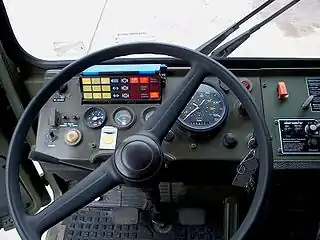 Cabin interior of a Category 1 truck
Cabin interior of a Category 1 truck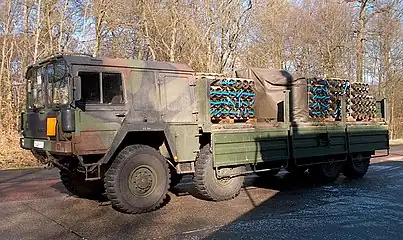 MAN Category I Type 464 LKW 10t mil gl MW Pritsche Kran 10,000 kg 8×8 cargo truck of the German Bundeswehr fitted with a self-recovery winch and body-mounted materials handling crane
MAN Category I Type 464 LKW 10t mil gl MW Pritsche Kran 10,000 kg 8×8 cargo truck of the German Bundeswehr fitted with a self-recovery winch and body-mounted materials handling crane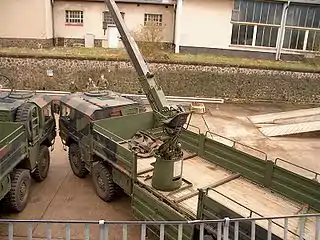 MAN Category I Type 464 LKW 10t mil gl MW Pritsche Kran 10,000 kg 8×8 cargo truck of the German Bundeswehr fitted with a self-recovery winch and body-mounted materials handling crane; the Atlas-Weyhausen 1-ton loading crane is deployed
MAN Category I Type 464 LKW 10t mil gl MW Pritsche Kran 10,000 kg 8×8 cargo truck of the German Bundeswehr fitted with a self-recovery winch and body-mounted materials handling crane; the Atlas-Weyhausen 1-ton loading crane is deployed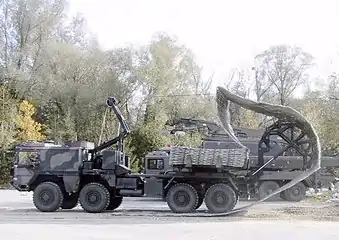 MAN Category 1 A1 with mobile field-deployable road system
MAN Category 1 A1 with mobile field-deployable road system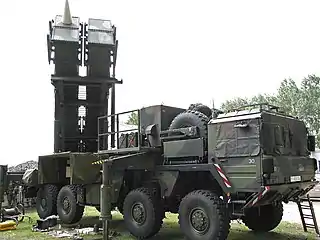 MAN Category I A1 with Patriot weapon system
MAN Category I A1 with Patriot weapon system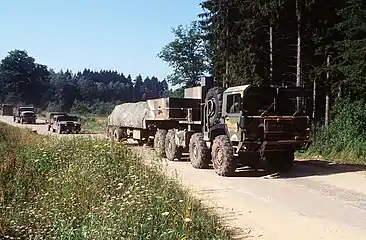 MAN Category 2 truck of US armed forces
MAN Category 2 truck of US armed forces
Bundeswehr replacement
On 6 July 2017 Rheinmetall MAN Military Vehicles announced it had entered a framework agreement with the German Bundeswehr to supply 2271 MAN HX2 trucks under the Bundeswehr’s Unprotected Transport Vehicle (UTF) programme. UTF will replace the older Category 1 trucks. The contract award has a potential value of around EUR 900 million. An initial order for 558 trucks with a value of around EUR 240 million was placed, this including special tools and training support. Delivery was to take place during the 2018-2021 timeframe.[5] RMMV announced on 12 June 2019 that the Bundeswehr had placed an order with the company for a second batch of unprotected transport vehicles. The order called for 252 trucks (161 5-tonne and 91 15-tonne) and was valued at EUR 92 million. The 252 vehicles ordered were delivered during 2019 and deliveries followed those of the original 558 trucks ordered at contract signing, the delivery timeline for these expedited. A further 60 trucks were ordered in November 2019, and the most recent order to date was announced in December 2019. This order calls for 1,000 trucks and is worth EUR 382 million including valued added tax. Of the latest order, 675 trucks are 5,000 kg payload and the remaining 325 are 15,000 kg payload. Production of this latest order commenced in January 2020, with delivery to be complete by the end of the year.
References
Notes
- 1 2 3 4 5 6 "MAN 4×4, 6×6, and 8×8 Category 1 (Kat 1) high-mobility tactical trucks (JLSU 2019/2020". Retrieved 11 March 2021.
- 1 2 3 4 5 6 7 "MAN 4×4, 6×6, and 8×8 Category 1 (Kat 1) high-mobility tactical trucks (JLSU 2020/2021". Retrieved 11 March 2021.
- ↑ "Philipp aus dem Hanfbachtal - Verkaufsfahrzeuge". 14 August 2011. Retrieved 14 August 2011.
- ↑ Operators Manual Truck, Tractor. Departments of the Army and the Air Force. March 1983. TM 9-2320-282-10.
- ↑ "Rheinmetall to modernize the Bundeswehr's fleet of logistic vehicles". Retrieved 6 July 2017.
Bibliography
- Peters, Heinz (2010). MAN Kat I: Taktische LKW der Ersten Folgegeneration der Bundeswehr / MAN Tactical Trucks of the Follow-On Generation of the German Bundeswehr. Militärfahrzeug Spezial No. 5027 (in English and German). Erlangen, Germany: Tankograd Publishing. OCLC 658237140.
- Schulze, Carl (2019). 'Cold War Warrior' MAN Kat I LKW: Die 5-Tonner, 7-Tonner und 10-Tonner MAN der Bundeswehr auf Manöver im Kalten Krieg / The 5-ton, 7-ton and 10-ton MAN-Kat I Trucks in Cold War Exercises with the German Bundeswehr. Militärfahrzeug Spezial No. 5081 (in English and German). Erlangen, Germany: Tankograd Publishing. OCLC 1135401657.